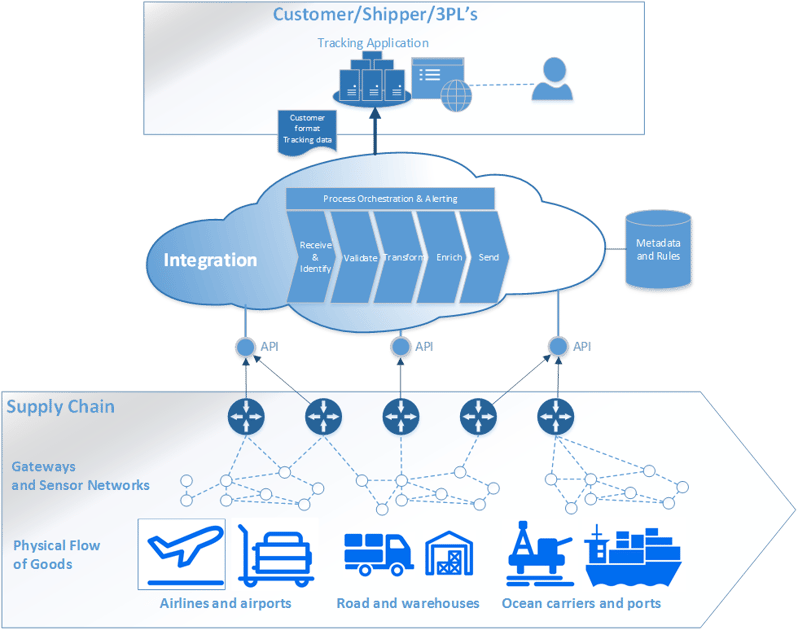The term 'Internet of Things' (IoT) has been a part of every self-respecting consultant's vocabulary in the recent years. Despite this, it, in fact, opens new interesting possibilities for companies to enhance the efficiency of their business. Supply chain management (SCM) is one of the most promising areas which may benefit greatly from modern IoT-type technologies, like for instance sensor networks that offer completely new ways for tracking your flow of goods within the supply chain. Currently used technologies for supply chain trackings, such as RFID or barcodes are feasible if your need is to track the location of goods from origin to a destination or when the goods have arrived at the predefined checkpoint, such as distribution center or are leaving that checkpoint. However, as soon as you want to start tracking, for example, the detailed route the goods have taken between different checkpoints or what kind of temperature or humidity the goods have been exposed to during their journey RFID and barcodes are running out of options. For this kind of more detailed tracking, you need to introduce more advanced technologies, like IoT sensors.
The average cost of the IoT sensors have been falling and the prices are now only a fraction of what they used to be 10-15 years ago. The overall durability and battery lifetime have also improved quite dramatically while the prices have sunken. From a technical point of view, a few cool features are that the sensor devices nowadays are capable to self-adapt to local conditions, they can form intelligent wireless networks autonomously and they are also able to store the measurements data until there is a gateway within reach through which the data can be pushed to a common network. All this make it financially and technically possible to utilize the latest sensor network technology to track your supply chain at a more detailed level than ever before.
Breaking down the IoT in supply chain tracking solution
The IoT sensors and gateways by themselves are not enough to provide all functionalities that a tracking solution may require. In addition, you also need some means to integrate the sensor measurements with the business applications in the right format and at right time. Due to their nature and the far-reaching optimization in terms of battery lifetime, sensor measurement data is typically very simplified and for example, it only contains the sensor identification and the values that as such are not enough to provide clear business context. This means that there is a need for solution layer which has the capability to provide the necessary integrations while enriching sensor measurements with metadata for business applications, so the users will be able to know what they are actually tracking.

Supply Chain
Sensor networks allow businesses to track any type of transport mode and basically any kind of goods. A trackable asset can be an ocean container, a transport pallet of fruits or a single parcel. Each sensor is specialized in tracking certain environment variable, like humidity, temperature or location. Sensors will measure the variable at regular intervals and store the value to a local storage until they can push them to the gateway. Gateway resides on the edge of the sensor networks being capable of receiving measurements, batching them, and carrying out protocol required mapping between sensor network and HTTP(S) transport protocol schemes.
Integration
Integration is preferably running on top of the cloud-based iPaaS platform which is capable to automatically scale up when there are high message volume peaks – which is a quite common situation in IoT scenarios. Integration provides APIs for the sensor gateways to push the sensor measurements forward. Upon receiving, integration will execute a pipeline, which comprises following steps:
1. Identify and authenticate the sender – for example, public key authentication. If needed, keys can also be used to encrypt the content.
2. Validate the content and in some cases the gateway, too. Once the gateway has processed the measurements data, it can process data in JSON, XML, in raw format or as it has been received from the sensors – this depends on the gateway. Nevertheless, integration must be capable of processing several different formats.
3. Transform measurements data into a format expected by the tracking application.
4. Enrich the measurement with the metadata to give it a contextual meaning. For example, the metadata may state that the sensor id 123456 has been bind to a box of lemons which have been picked up from Uncle X’s farm on 3rd of July 2017. If the sensors are designed to be reusable and the supply supports the reusability as well, integration must provide means for the customer to re-initialize the metadata when the sensors are circled back to the beginning of the supply chain. Furthermore, if required, integration platform may also run the measurements through a business rules engine logic. For instance, A single rule may state that the temperature of the lemons (sensor 123456) must not go below zero degrees at any point during the journey. If there are rules that are not true then an automatic alarm can be generated for the right agent.
5. Send the measurements data to a business application or applications. Depending on the use case, there may be several applications receiving the same measurements, where one could be logistics providers TMS system and the other one is the shipper’s tracking system.
Utilizing internet of things in supply chain management allows each parties to benefit from new opportunities. It is just a matter of who will make the first step. Freight forwarders, carriers, and 3PLs with the initiative will deploy IoT-based, more in-depth supply chain tracking and provide that as an added service for their customers. Pretty soon big shippers, with enough leverage, will demand them to do it anyway.


